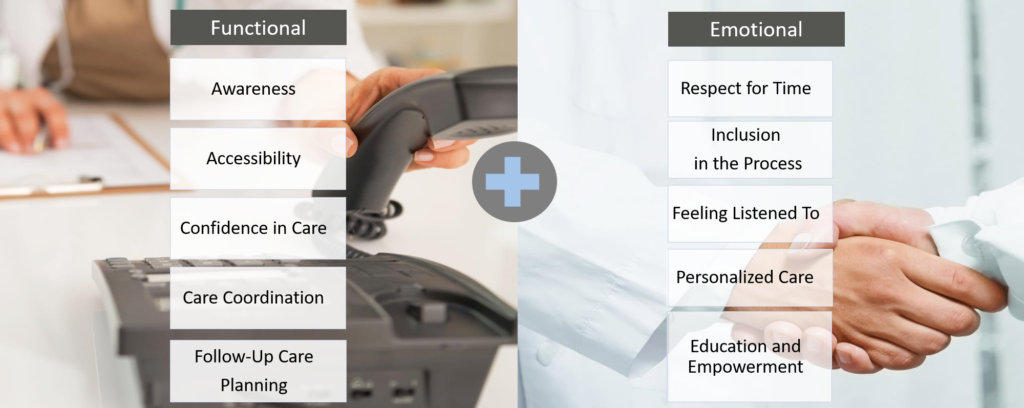
Consumerism
in Healthcare
Strategies for Attracting Today’s Empowered Healthcare Consumer
Consumerism is a buzzword that can mean many things, but in healthcare a consumerism-related theme that is weaved through every interaction and touchpoint is empowerment. Empowered patient-consumers have unprecedented choices, access to options, and tools to make informed decisions. They are more active in their willingness share feedback about their experiences, participate in decision-making about their health care and evaluating choices available.
In response, a new set of healthcare competitors is emerging, particularly in the outpatient setting. Industry disruptors are promising to fill gaps that meet the needs of empowered consumers. Amazon, for example, is launching a non-profit, data-driven approach to cut costs and use digital tools for chronic disease management. Apple is gaining presence in wellness monitoring and is exploring ideas for health records apps. Facebook, CVS, even rideshare services are all attempting jump into the game.
Meeting the needs of empowered consumers demands authentically engaging with customers in new ways.
Here are some strategies that can help:
- Promote care coordination through integration of CRM and EMR.
EMR is designed to for clinicians to efficiently access records, but is not designed to facilitate relationship-building or interaction. In contrast, a CRM can provide a holistic view of the patient’s needs and preferences that is critical to coordination of care over time Today’s patients expect that they will be “remembered” across appointments, specialties and touchpoints. When a patient sees the doctor regularly, “remembered” means referring to their concerns from a previous appointment or asking about important life events that have already been discussed. For new visits, “remembered” means that the provider has reviewed their records, concerns, and history before walking into the room – especially if the patient came as a referral.
2. Increase engagement with digital tools.
Information is fundamental to empowerment – and must be available the right time and place. This is why digital tools are highly sought and promote patient loyalty. A recent survey from NTT Data emphasizes this, finding that today’s tech-savvy consumers expect fast and easy digital experiences, yet perceive healthcare as lacking in this area. Top areas for improvement include: ease of searching for a doctor or specialist, accessing health records, changing or making an appointment, accessing test results, paying bills, and filling prescriptions.
3. Meet needs for convenience and efficiency.
Although changing the typical 8:00-5:00 mindset will take time, it will be critical for competing with industry disruptors which focus on on-demand services and convenience. Patients want to schedule appointments after-hours or when they think of it – which may mean requesting or scheduling an appointment online or via phone at night. Especially for frequent appointments such as therapy, patients don’t want to (or often can’t) skip work or take their children out of school early consistently – so after hours and weekend scheduling options provide a competitive advantage. In fact, patients are often willing to forego their preferred provider/system in provider of one that offers appointments when they need them.
4. Create environment that fosters respect and partnership.
Meeting patient needs for empowerment requires that they are engaged as a partner in their care and feel respected as a person rather than just a case. This includes providing resources and communication that promote patient education, shared decision making, and ways for patients to take responsibility for their healthcare. A challenge with this is that clinical providers often don’t have the time to have these conversations. However, empowerment doesn’t happen only in the exam room. Inclusion of patient advocates and educational resources in multiple formats is helpful. Providers can share information with patients via the portal, and automate surveys post-visit to ensure patients understand their care plan.
It’s important that patients have both their functional and emotional needs considered – it’s not just about what tools or resources are available, but also about how their unique needs are considered as part of the process.

5. Be Price Transparent.
We saved one of the most complex for last. In the past, consumers were in the dark about healthcare pricing and what bill they would receive after their services. The pricing dynamic in healthcare is unlike almost any other consumer experience in our country – and is increasingly unacceptable to consumers.
Most hospitals today can’t provide an accurate cost estimate, or comparison of alternatives. In our experience, one of the biggest frustrations related to large medical centers is receiving multiple bills – from the doctor, facility, and ancillary services – that they were not expecting. Or being charged for a hospital fee instead of an outpatient visit. In coming months price transparency may even move beyond a consumer expectation to a legal requirement, as legislation is currently being discussed that would require disclosure of prices in consumer-friendly manner.
Upfront price estimates could be a benefit to hospitals as well as patients. For example, Modern Healthcare’s report shares the example of Baylor Scott & White Health, a Texas health system that has been a pioneer in price transparency, which calls patients to provide a cost estimate for high dollar hospital services. Not only has the hospital seen an increase in their patient experience, but they have also seen that these upfront price estimates make patients more likely to pay their bill – increasing their point of service collections by 60%.
It’s likely that healthcare price transparency will become more than a consumer demand/preference in the coming years. In late 2019, the Department of Health and Human Services announced that the Centers for Medicare & Medicaid Services (CMS) is issuing rules regarding price transparency that are meant to empower patients (read more here). These rules will require that pricing information be made publicly available. As stated by Secretary Alex Azar “Right now our system probably deserves an F on transparency” and there is a need to provide patients with more information and control in this area. This is just one example of how the changes demanded by consumers today are becoming not just a competitive advantage but a requirement to do business – and demonstrates why it is imperative that healthcare organizations stay ahead of the curve on meeting these demands.
Let’s Talk
We will help you overcome strategic challenges to realize the business value you seek.
